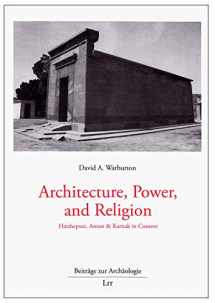
Architecture, Power, and Religion: Hatshepsut, Amun & Karnak in Context (7) (Articles on Archaeology / Beitrage zur Archaologie)
ISBN-13:
9783643902351
ISBN-10:
3643902352
Author:
David A Warburton
Publication date:
2012
Publisher:
LIT Verlag
Format:
Hardcover
432 pages
FREE US shipping
Book details
ISBN-13:
9783643902351
ISBN-10:
3643902352
Author:
David A Warburton
Publication date:
2012
Publisher:
LIT Verlag
Format:
Hardcover
432 pages
Summary
Architecture, Power, and Religion: Hatshepsut, Amun & Karnak in Context (7) (Articles on Archaeology / Beitrage zur Archaologie) (ISBN-13: 9783643902351 and ISBN-10: 3643902352), written by authors
David A Warburton, was published by LIT Verlag in 2012.
With an overall rating of 4.3 stars, it's a notable title among other
books. You can easily purchase or rent Architecture, Power, and Religion: Hatshepsut, Amun & Karnak in Context (7) (Articles on Archaeology / Beitrage zur Archaologie) (Hardcover) from BooksRun,
along with many other new and used
books
and textbooks.
And, if you're looking to sell your copy, our current buyback offer is $0.49.
Description
This book explores the fundamental question of the origins and nature of monumental religious architecture. The principal argument is that the origins of monumental religious architecture were basically aspatial and that the gradual incorporation of functional space into religious architecture can be related to transformations in religious thought. Although the discussion ranges across the Old World, the argument centers on Egypt and the Egyptian female king Hatshepsut: she set the tone for the New Kingdom by tying her legitimacy to Amun and the monuments she built for him. This leads into the issues of power and political legitimacy, and their relevance to myths. The basic contention is that the political ideologies of the Near Eastern Bronze Age contributed fundamentally to what later became the phenomenon we know as "religion," and that the history of the architecture must be understood in order to understand both religion and architectural space. (Series: Articles on Archaeology / Beitrage zur Archaologie - Vol. 7)


We would LOVE it if you could help us and other readers by reviewing the book
Book review

Congratulations! We have received your book review.
{user}
{createdAt}
by {truncated_author}


